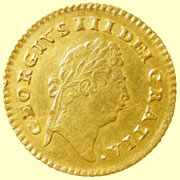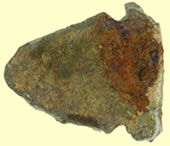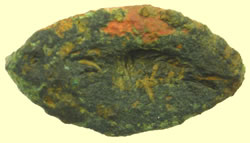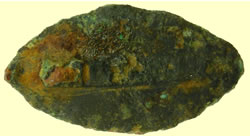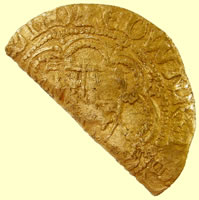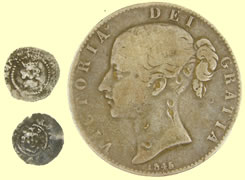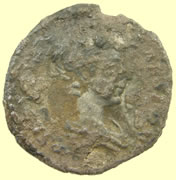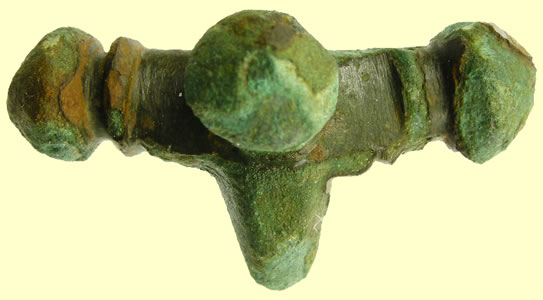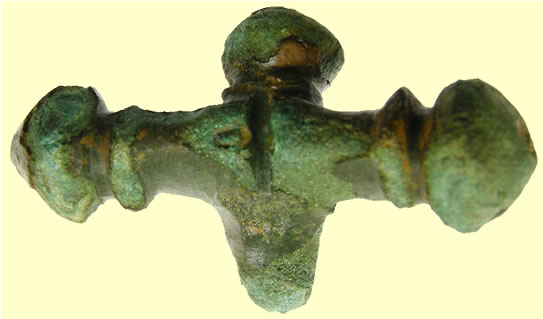

Metal detecting holidays in England with the World's most successful metal detecting club.
Twinned with Midwest Historical Research Society USA
2009 Oct II finds page |
1798 George III milled gold 1/3 guinea |
|||||||||||
|
|
||||||||||
Neat relic - 1804 George III milled gold 1/3 guinea forgery |
Bronze arrow head ?? |
||||||||||
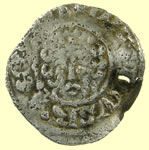 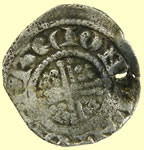 |
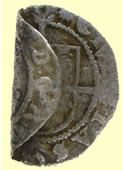 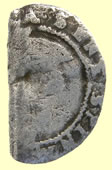 |
||||||||||
1217 /8 Henry III hammered silver short cross penny Class 7a Obv HENRICVS REX Obv ** REI ON LVN - Moneyer Gefrei of London |
1584-6 Elizabeth 1st hammered silver half groat - Escallop mint mark 6th issue |
||||||||||
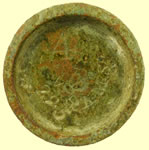 |
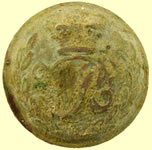 |
 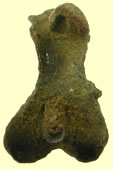 |
|||||||||
20thC 4 grams trade weight |
Royal Engineer Department
|
17thC mount with 2 integral lugs |
|||||||||
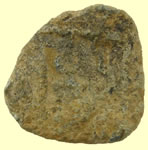 |
 |
 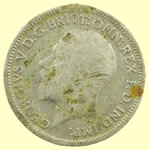 |
|||||||||
Lead seal |
Essex Constabulary |
1930 George V milled silver sixpence |
|||||||||
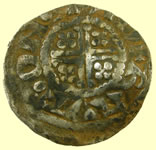 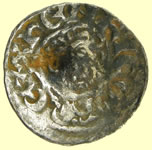 |
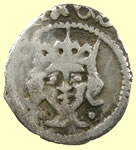  |
||||||||||
1204/5 John hammered silver short cross penny -Class 5c Obv HENRICVS REX Rev RAVF .ON. WIN -Moneyer Ravf of Winchester mint |
Irish 1473 -1478 Edward IV hammered silver penny - quatrefoils at centre of reverse cross- pellets by neck on obv |
||||||||||
 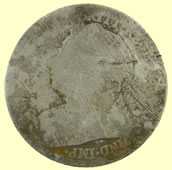 |
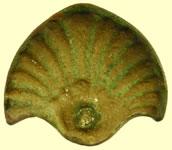 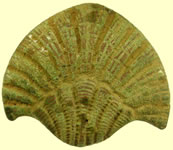 |
||||||||||
Victorian milled silver shilling |
17thC mount |
||||||||||
|
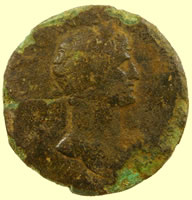 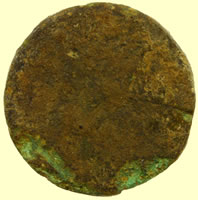 |
||||||||||
3rd C Roman 'Newstead' type lorica tie loop
|
Roman 2nd bronze coin 32.93mm, 21.49g
is a sestertius of Hadrian - and a very young portrait style, too - his portrait still resembles Trajan at this point and he's shown with a very long neck and bare chest - probably about 117-120 AD, but without a clue about the reverse I can't be any more specific. Mark |
||||||||||
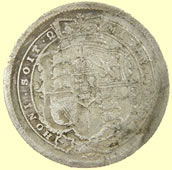  |
 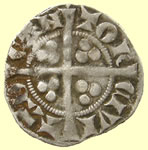 |
||||||||||
1816 George III milled silver shilling |
1341 Edward III hammered silver florin penny Obv EDWAR R ANGL DNS HYB Rev CIVI/TAS/CAN/TOR - Canterbury mint |
||||||||||
 |
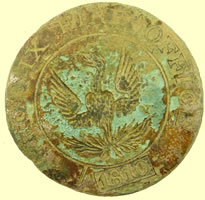 |
 |
|
||||||||
'Tally Ho' hunting button |
Really neat dated button -PHOEN IX Fire Office 1810 |
? |
2 - 15thC casket keys |
||||||||
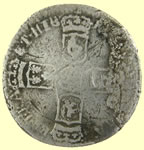 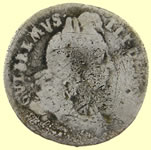 |
 |
|
|||||||||
1696 William III milled silver sixpence |
Medieval lead trade weight |
17thC mount with 2 integral lugs |
|||||||||
|
 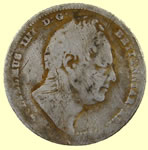 |
||||||||||
17thC mount with 2 integral lugs |
1834 William IV milled silver sixpence |
||||||||||
 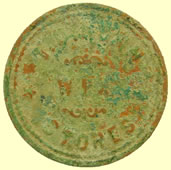 |
 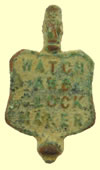 |
||||||||||
20thC - £1 - T D Nunn Wix store token |
Georgian advertising watch winder - J.W.Benson Watch & Clock maker |
||||||||||
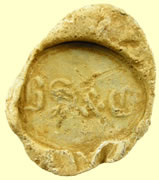 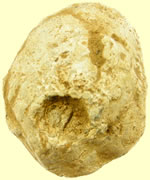 |
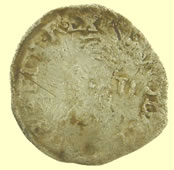 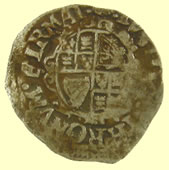 |
||||||||||
Post medieval lead seal |
1636-8 Charles 1st hammered silver half groat - Tun mint mark |
||||||||||
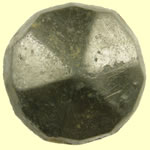 |
 |
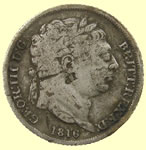 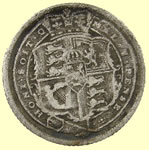 |
|||||||||
Georgian pewter button |
Corporation button |
1816 George III milled silver six pence |
|||||||||
 |
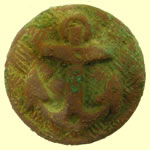 |
|
|||||||||
Britain's Merchant Navy Bliss Bros Ltd Rd 665050 |
?? |
Medieval bronze vessica seal matrix - crow impression facing left |
|||||||||
 |
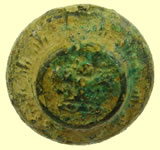 |
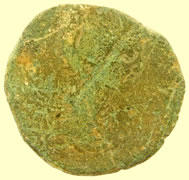 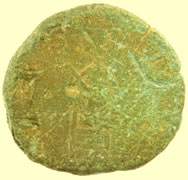 |
|||||||||
Honourable East India Company, Ship's Officers Button |
?? |
2nd C Roman bronze coin |
|||||||||
 |
 |
||||||||||
Georgian pipe tamper |
16thC stone caronade shell |
||||||||||
 |
 |
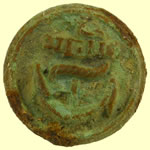 |
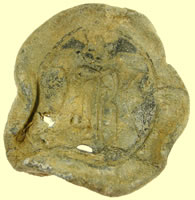 |
||||||||
Roman buckle tongue |
18thC Dutch lead bale seal |
1900 Generic merchant navy |
17thc lead document seal |
||||||||
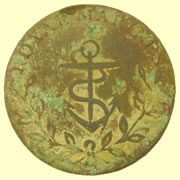 |
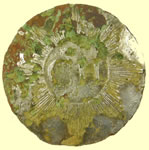 |
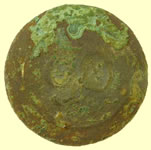 |
 |
||||||||
Unrecorded Royal Marines one piece button |
Military button CH ?? |
|
Medieval lead gaming token |
||||||||
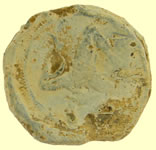 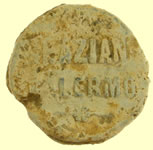 |
 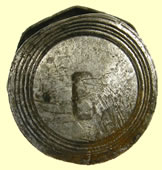 |
||||||||||
Post medieval lead bale seal |
18thC Royal Navy silver stud |
||||||||||
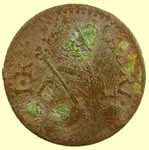 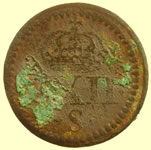 |
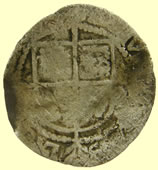 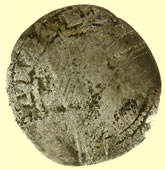 |
||||||||||
1603 James 1st gold Unite, 2nd coinage, revalued coin weight XXIIs - 22 shillings - 10gm |
16thC Elizabeth 1st hammered silver half groat |
||||||||||
 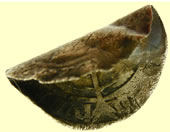 |
 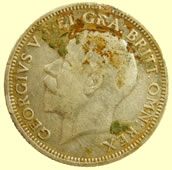 |
||||||||||
16thC Elizabeth 1st hammered silver half groat |
1929 George V milled silver shilling |
||||||||||
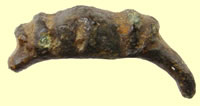 |
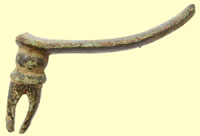 |
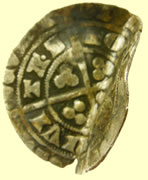 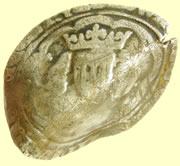 |
|||||||||
Roman open ended buckle fragment |
Georgian spur fragment |
1340 Edward III hammered silver groat Rev CIVI/TAS/LON/DON - London mint |
|||||||||
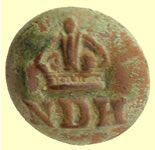 |
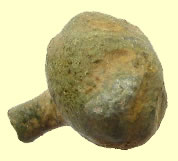 |
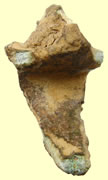 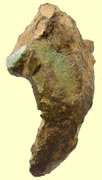 |
|||||||||
WWII civilian button ? |
Medieval pin head |
2nd C Roman fibular brooch |
|||||||||
  |
 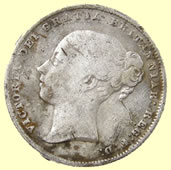 |
||||||||||
17thC mount with 2 integral lugs |
1864 Victorian milled silver sixpence |
||||||||||
 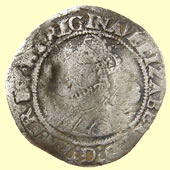 |
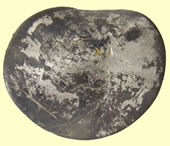 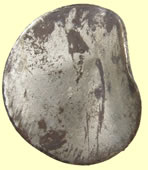 |
||||||||||
1561 Elizabeth hammered silver 3 pence |
1704 Queen Anne milled silver shiliing |
||||||||||
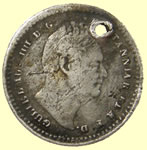 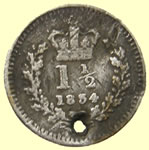 |
  |
||||||||||
1834 William IV milled silver 1 1/2 pence |
1461-70 Edward IV hammered silver penny - York Archiepiscopal issue Type VIIi, G and key by bust - Quatrefoil with pellet at centre of reverse |
||||||||||
 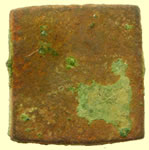 |
 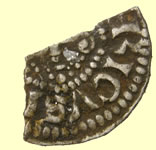 |
||||||||||
17thC apothecary weight |
1247 Henry III hammered silver voided longcross cut halfpenny - Class 1b Obv HENRICVS REX Obv WIL/LEM/EON/KAN - Willeme of Canterbury
|
||||||||||
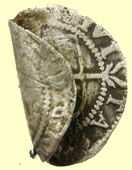 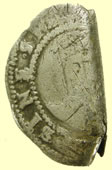 |
|
||||||||||
16thC Elizabeth 1st hammered silver half groat |
1247 Henry III hammered silver shortcross cut halfpenny Obv HENRICVS REX Rev ** NRI.on -Henri of London |
||||||||||
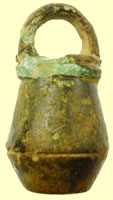 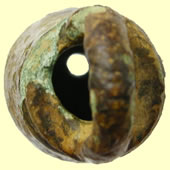 |
|||||||||||
Bronze Romano/British hanging weight ? |
|||||||||||
Taco'd Circa 1350 Edward hammered gold 1/4 noble - Cross 3 -Needs straightening to ID exact type from rev shield. Obv + EDWARD DEI GRA REX ANGL Rev 18.92mm. 1.9g |
|||||||||||
 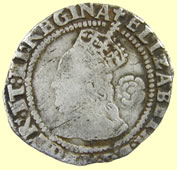 |
  |
||||||||||
1580 Elizabeth 1st hammered silver three pence - Latin cross mintmark - 5th issue 18.06mm, 1.48mm |
1633-4 Charles 1st hammered silver shilling - Portcullis mintmark Group D Garnished oval shield with CR at sides Tower mint under Charles I |
||||||||||
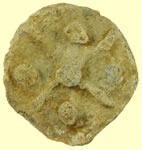 |
 |
  |
|||||||||
15thC lead long cross token - type 2 |
18thC 2nd regiment of foot regiment button (not in ref books) |
1762 George III milled silver 4 pence |
|||||||||
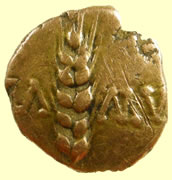  |
|||||||||||
10 to 40 AD Cunobelin Celtic gold qtr stater - sent to CCI for recording 12.41mm, 1.26g |
|||||||||||
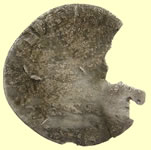 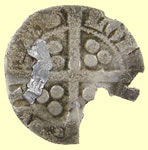 |
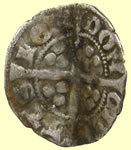  |
||||||||||
Medieval hammered silver penny Obv CIVI/TAS/LON/DON - London mint |
1341 Edward hammered silver florin penny Obv EDWAR ANGL DNS HYB Obv CIVI/TAS/LON/DON - London mint |
||||||||||
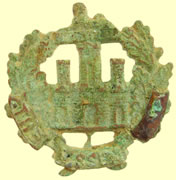 |
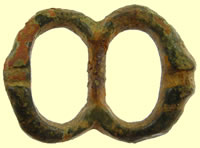 |
 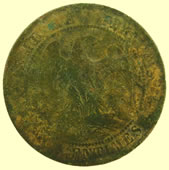 |
|||||||||
Essex regiment cap badge |
1550-1650 buckle |
1853 Napoleon III French copper coin |
|||||||||
 |
 |
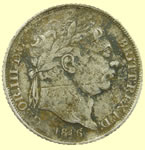  |
|||||||||
Customs button |
1900 Generic merchant navy button |
1816 George III milled silver sixpence |
|||||||||
 |
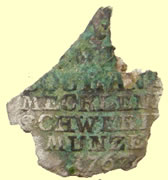 |
 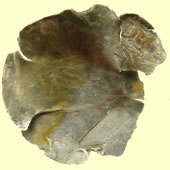 |
|||||||||
Georgian button |
1767 Continental billion silver coin |
1554 Mary hammered silver groat |
|||||||||
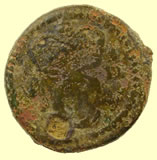 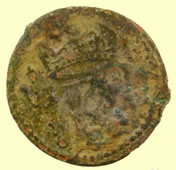 |
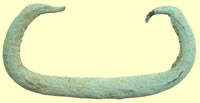 |
 |
|||||||||
Great find - 1625 Charles 1st sixpence coin weight - 3gm Obv VI R D Rev VI C DE |
Roman buckle |
17thC Pewter finial |
|||||||||
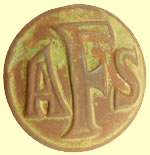 |
 |
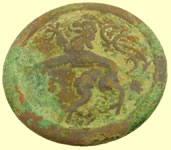 |
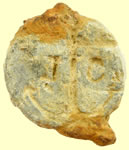 |
||||||||
WWII Auxilery Fire service button |
19thC livery button |
WWI Prussian army button |
Navy bale seal - JC Anchor |
||||||||
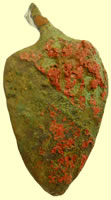 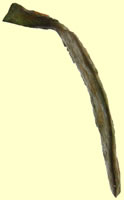  |
|||||||||||
Medieval heraldic shield pendant - yellow and red enamelling remaining - Cal Jim just ID'd the family Jean de Chalon "le sage" (1190-1267) |
|||||||||||
 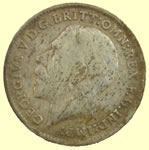 |
 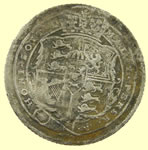 |
||||||||||
1917 George V milled silver 3 pence |
1816 George III milled silver sixpence |
||||||||||
 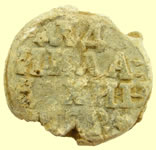 |
 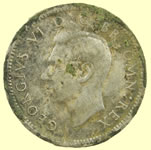 |
||||||||||
1825 Russian lead bale seal |
1943 George VI milled silver sixpence |
||||||||||
 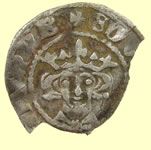 |
  |
||||||||||
1279 Edward hammered silver penny - Class 7 Initial mark - Cross Pattee Rose on breast type Obv EDW **** DNS HYB Obv CIVI/TAS/LON/DON - London mint |
1816 George III milled silver sixpence |
||||||||||
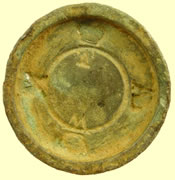 |
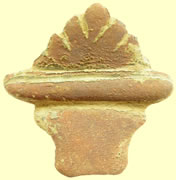 |
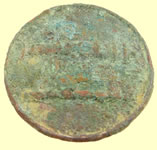 |
|||||||||
Facinating London trade weight - Stamped Crown W for 1696 William III and both Crown A for Queene Anner 1704 - Restamped after Williams death |
17thC mount with 2 integral lugs |
19thC livery button - cannon |
|||||||||
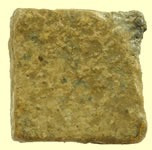 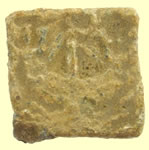 |
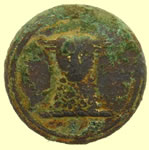 |
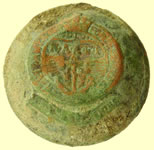 |
|||||||||
14thC British Gold nobel lead coin weight - ship obverse |
19thC livery button |
Navy button - not checked ref books yet |
|||||||||
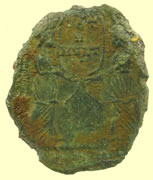 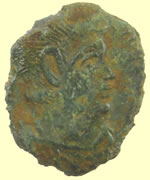 |
|||||||||||
Another Roman coin find from the reported hoard Unless I am mistaken, all 7 of these belong to the brother team of Magnentius & Decentius - a fairly short-lived (350-353 AD) Augustus/Caesar pair of the sort promoted to Augustus, ad-hoc, by their legions. This was a very common story during the chaos-years of the later 3rd century, but happened far less often in the 4th. Magnentius had been a top general of Constans' - his army proclaimed him Augustus and since Constans did him the favor of being captured and executed conveniently quickly - within a few months - Magnentius was duly recognized as Augustus in most of the Western provinces in 350. The next year he elevated his little brother Decentius to be his colleague Caesar.
Constantius II was not pleased by the Western upstarts and within 2 years had defeated them in a couple of significant battles. Realizing the jig was up, they both committed suicide in 353.
Although these reverse types are known for other rulers (for whom they are pretty rare), they are especially associated with Magnentius & Decentius, both of whom were always portrayed "bare headed" - no laurels or diadems, etc. - and both of whom sported distinctive "mullett" hairdos like you see on the clearest specimens here. Since I believe the obverse legend on that nice one of Bruce's ends in "AVG", I'd say it's most likely Magnentius. Any on which the obverse legend ends (around 5:00) in CAES, CAESAR, NOB C, or NC can safely be assumed to be Decentius.
The type with the 2 Victories resting shield inscribed: VOT / V / MVLT / X on a cippus (or just holding it between them) woul have a legend like: VICTORIAE DD NN AVG ET CAES - and was common for both of them. The large Chi-Rho Christogram reverse was used on both the centenionalis and short-lived double-centenionalis denominations - it's not really scarce, but is sought-after making it a bit more expensive for those wanting to buy one. This is a common factor in ancient coins, those with some sort of "religious" reference are always found desirable by folks who have no other interest in ancient coins, thereby driving up the prices (like the so-called "Tribute Penny" denarius of Tiberius - of which your diggers have found several - which is the most common silver coin of the early 1st century, but sells for 3-4 times as much as any other).
This pair struck only in the Western mints: Amiens, Trier, Lyon, Arles, Aquilea, Rome and Siscia
You have the Chi-Rho reverse 90º counter-clockwise out of alignment, by the way. in the left and right interstices of the Chi are "A" and "W" (Alpha/Omega). You can see these letters pretty clearly on this specimen although the "P"-shaped top of the Rho seems to have taken too much damage to be visible.
Some examples from my collection:
Magnentius: Chi-Rho double-centenionalis: http://www.stoa.org/gallery/album167/26_Magnentius_SAL_AMB
typical 2 Victories:
2 Victories from a British MD find:
a couple less-common reverses:
Decentius:
Mark
|
|||||||||||
 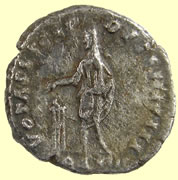 |
|||||||||||
2ndC Roman silver coin sent off for ID 17.05mm, 2.79g Mark Lehman just sent me this feedback & ID on the coin
The denarius is from Antoninus Pius, who, as you're probably aware, built a second, more northerly wall between Britain and the "barbarian north" - although of earth rather than stone and, I assume, not nearly so well appointed by way of amenities for its garrisons.
This piece is dated by the obverse and reverse legends to December 10, 159 - December 9,160 AD. Minted in Rome - the obverse should read: ANTONINVS AVG PIVS P P TR P XXIII.
The reverse shows Antoninus, togate, sacrificing at a tripod altar and holding a scroll - it reads VOTA SVSCEP DECENN III COS IIII
RIC III 306, RSC 1113.
This reverse commemorates his completion of his 2nd Decennalia and states that he has undertaken the vows for his 3rd as the Pontifex Maximus of the State religion. At various intervals, usually 5's and/or 10's of years within the reign, the emperor performed ceremonies in thanks for his successful reign and pledging to make similar sacrifices if the gods give him another 5 or 10 years of "success". Although in later years, emperors tended to "anticipate" these ceremonies - sometimes by many years - and they cease to be an accurate dating feature, in the 2nd century, this ceremony would have been on the 20th anniversary of his ascension on July 10, 138 and been a pretty big official celebration. This coin, then, is repeating the "news" of him having celebrated his 2nd Decennalia the previous year, and having made his vows for the 3rd, which he would not live to see, dying at Lorium, March 7, 161.
Many consider the reign of Antoninus as the true "Golden Age of Rome" - the apex of Roman power and civilization. Although the allegorical personification of Britannia was first introduced by Hadrian as a reverse type for sestertii of his "Grand Tour" series, the Britannia seated on a rock reverse which would be adapted for use on pennies and half-pennies in the 18th-20th centuries, was the reverse type on a very large emission of Antoninus' copper asses minted "in the field" in Britain during his reign.
Mark
|
|||||||||||
 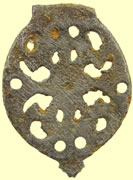 |
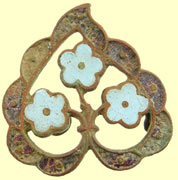 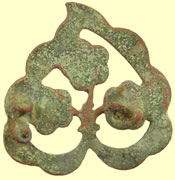 |
||||||||||
17thC clothing fastener |
Victorian brooch |
||||||||||
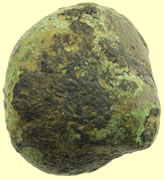 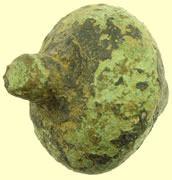 |
 |
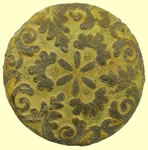 |
|||||||||
Finial |
19thC livery button |
Georgian button |
|||||||||
  |
|||||||||||
Romano latch key |
|||||||||||
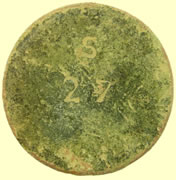  |
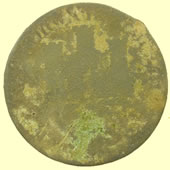 |
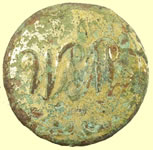 |
|||||||||
1760-1773 - 27 shilling coin weight for 4000 reis (Moidore) Portuguese gold coin |
18thC Conder token |
Monogrammed button |
|||||||||
 |
|||||||||||
C17th C Complete silver Bokin needle - reported as treasure to the museum
|
|||||||||||
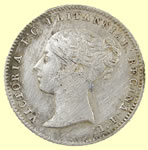 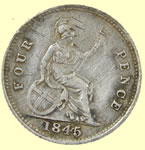 |
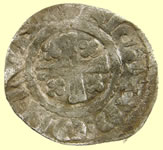 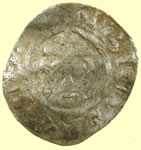 |
||||||||||
1845 Victorian milled silver groat |
1199 King John hammered silver shortcross penny Obv HENRICVS REX Rev RICHARD ON LVND - Moneyer Richard of London |
||||||||||
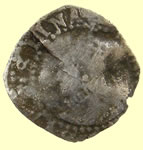 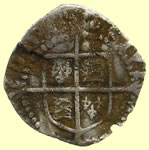 |
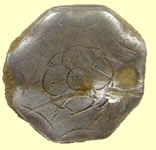 |
 |
|||||||||
16thC Elizabeth 1st hammered silver penny |
18thC silver navy button |
||||||||||
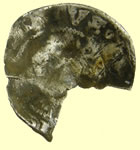  |
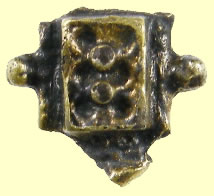 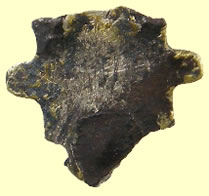 |
||||||||||
1272 Edward 1st hammered silver penny Rev CIVI/TAS/EBO/RACI - York mint |
16thC Tudor gilded silver fastener fragment - reported as treasure |
||||||||||
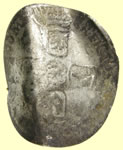 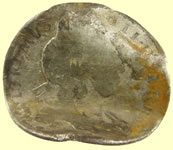 |
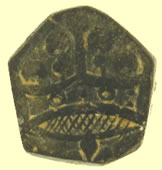 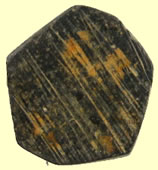 |
||||||||||
1696 William III milled silver lovetoken |
1293 – 22 August 1350 French coin weight for the couronne d'or of Philip VI |
||||||||||
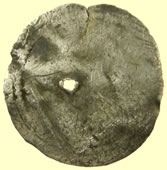 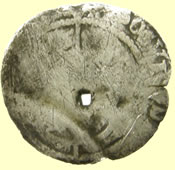 |
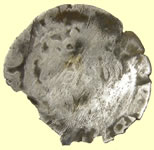 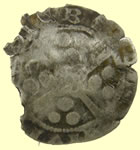 |
||||||||||
1587 Elizabeth 1st hammered silver half groat |
1413 Henry hammered silver penny - Archiepiscopal issue -quatrefoil with pellet on reverse cross Obv ********ANGLIE Rev CIVI/TAS/EBO/RACI - York mint |
||||||||||
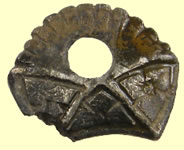 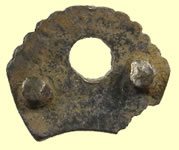 |
 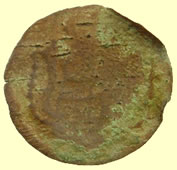 |
||||||||||
Victorian silver mount |
1790 German City of Osnabruck- copper 1 Heller coin |
||||||||||
Size comparison of Henry half penny, Edward farthing & Victorian crown |
|||||||||||
 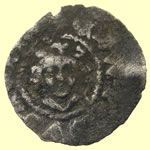 |
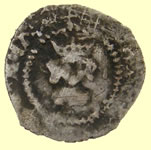 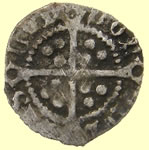 |
||||||||||
1300-10 Edward II hammered silver farthing- new issue with inner circles both sides - oval flan - Type 28f Obv EDWARDVS REX AN Rev CIVI/TAS/LON/DON - London mint 0.31g,11.07mm |
1485 Henry VII hammered silver half penny - Cross furchee - Open crown Obv HENRIC *** REX Rev CIVI/TAS/LON/DON - London mint 0.39g,12.55mm |
||||||||||
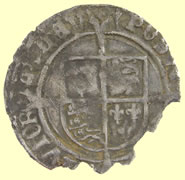  |
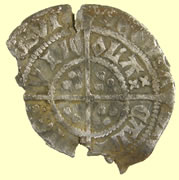 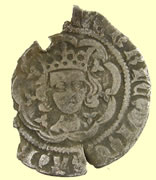 |
||||||||||
1532-42 Henry VIII hammered silver groat - arrow mintmark First period - London, Tower (POSUI)
|
1430-34 Henry VI hammered silver half groat -Pinecone Mascle issue Rev VILLA/CALISIE - Calais mint |
||||||||||
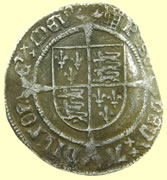 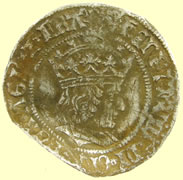 |
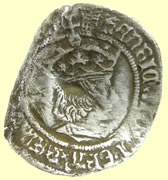 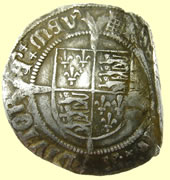 |
||||||||||
1509-26 Henry VIII hammered silver groat - Portcullis crowned initial mark Portrait of Henry VII but name of Henry VIII |
1509-26 Henry VIII hammered silver groat - Portcullis crowned initial mark Portrait of Henry VII but name of Henry VIII |
||||||||||
 |
 |
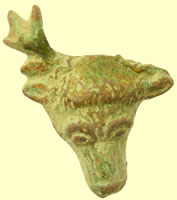 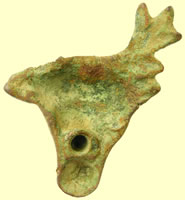 |
|||||||||
Medieval finial |
WWI Trench art |
Georgian mount with single screw fixing |
|||||||||
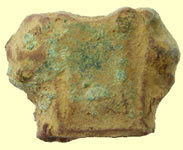 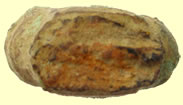 |
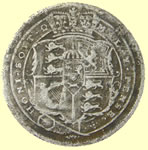 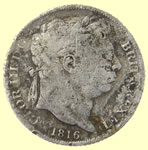 |
||||||||||
Medieval knife pommel |
1816 George III milled silver sixpence
|
||||||||||
 |
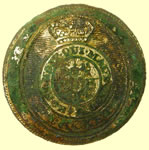 |
  |
|||||||||
Military button ? |
One piece Navy button HONI SOIT QUI MAN Y PENSE PACKET Honi soit qui mal y pense (Old French: shame upon him who thinks evil of it) RN - Packet Service c.1800-1811 |
17thC mount with 2 integral lugs |
|||||||||
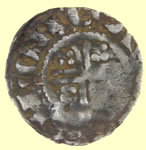 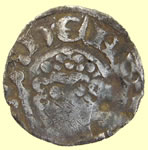 |
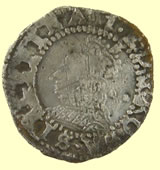 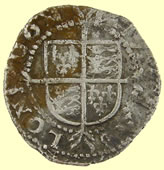 |
||||||||||
1247 Henry III hammered silver short cross penny - Class 7b Obv HENRICVS REX Rev IOAN ON CANT - Moneyer Ioan of Canterbury |
1602 Elizabeth 1st hammered silver half groat - 2 mint mark - 7th issue |
||||||||||
 |
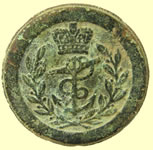 |
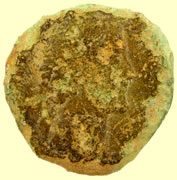 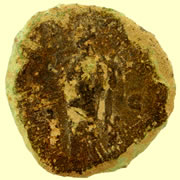 |
|||||||||
Georgian watch winder |
|
2nd C Roman bronze coin- sent off for ID |
|||||||||
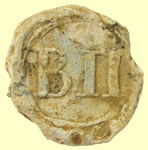 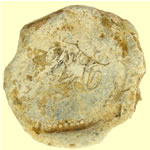 |
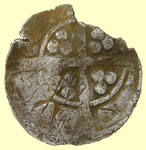 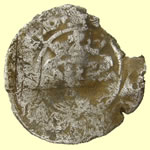 |
||||||||||
Post medieval lead bale seal |
1413-22 Henry V hammered silver penny - Initial mark mullet Obv CIVIT/TAS/DVR/ENE - Durham mint |
||||||||||
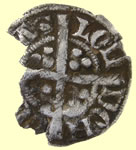 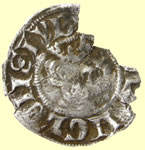 |
 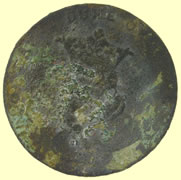 |
||||||||||
1279 Edward 1st hammered silver penny - Class 5a Obv **** ANGL DNS HYB Rev CIVI/TAS/LON/DON - London mint |
1794 Halfpenny of Lancaster OBVERSE: IOHN OF GAUNT DUKE OF LANCASTER. Star under bust. A flaw gives an impression of a nose-ring. REVERSE: Shield with lion. LANCASTER HALFPENNY 1792. EDGE: PAYABLE IN LANCASTER LONDON OR BRISTOL |
||||||||||
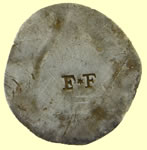 |
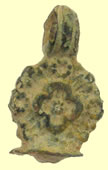 |
 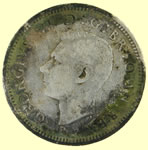 |
|||||||||
1696 William III milled silver sixpence love token overstamped F*F |
Georgian fob seal holder top |
1939 George VI milled silver sixpence |
|||||||||
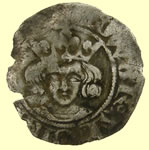 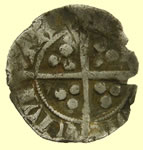 |
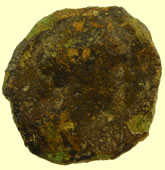 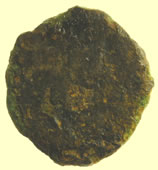 |
||||||||||
1341 Edward III hammered silver Florin penny - annulet stop after R on Obv Obv EDWAR ANGL *** Rev CIVI/TAS/LON/DON - London mint |
2ndC Roman bronze coin- sent off for ID |
||||||||||
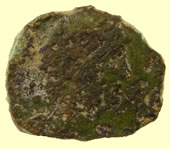 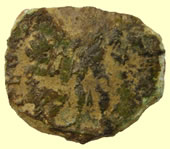 |
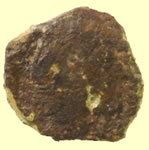 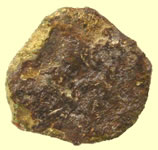 |
||||||||||
3rdC Roman bronze - sent off for ID |
3rdC Roman bronze - sent off for ID |
||||||||||
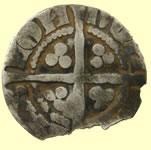 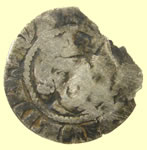 |
  |
||||||||||
1279 Edward 1st hammered silver penny Obv **** ANGL DNS HYB Rev CIVI/TAS/LON/DON - London mint |
1639-40 Charles 1st hammered silver half groat - Triangle mint mark - Tower mint under Charles |
||||||||||
 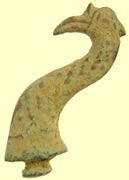 |
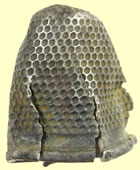 |
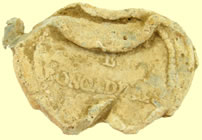 |
|||||||||
These are in the Roman ref book as military mounts- metal looks to good to be Roman |
Geogian silver thimble |
Post medieval lead bale seal |
|||||||||
 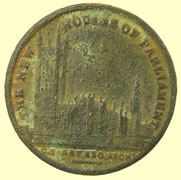 |
 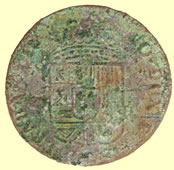 |
||||||||||
Great find 1846 Victorian 'New houses of Parliament' token C.S Barry Esq Arch |
Coninental copper coin ? |
||||||||||
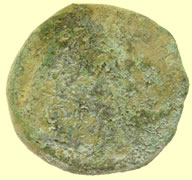 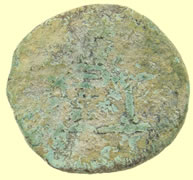 |
  |
||||||||||
Unusual 2ndC Roman bronze coin |
1199 King John hammered silver short cross cut halfpenny - Class 5b Obv HENRICVS REX MONEYER Gifrie of Norwich |
||||||||||
 |
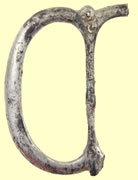 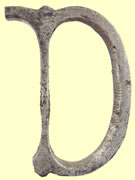 |
||||||||||
Medieval decorated purse bar |
1500 -1650 solid silver buckle - reported to museum as treasure |
||||||||||
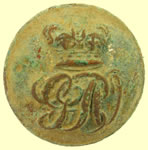 |
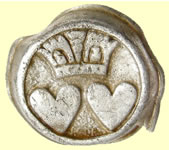 |
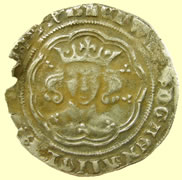 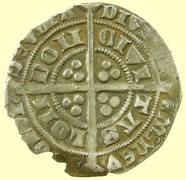 |
|||||||||
GPO - General Post Office - Don't look like a QVCPoss' ERII crown |
17thC Charles II silver button - report to museum as treasure |
1354-1355 Edward III hammered silver groat - Series E, fleur de lys on breast and tressures Rev CIVI/TAS/LON/DON - London mint 4.04g, 26.45mm |
|||||||||
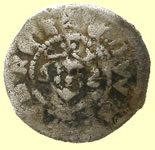 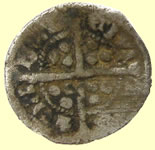 |
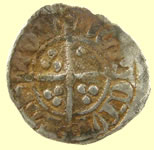 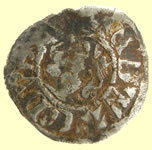 |
||
1300-10 Edward II hammered silver farthing - New issue inner circles both sides - Type 28 Obv +EDWARDVS REX Rev CIVI/TAS/LON/DON - London mint |
1310-14 Edward II hammered silver halfpenny - Type 12, New obverse legend Obv +EDWARDVS REX Rev CIVI/TAS/LON/DON - London mint 0.57g, 14.88mm |
||
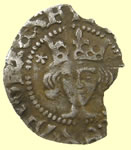 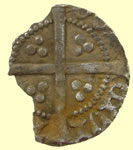 |
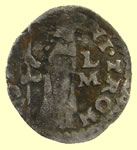 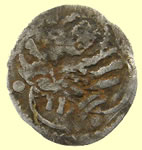 |
||
1413-22 Henry V hammered silver penny - mullet to left of crown, annulet by right of crown Durham mint
|
Nicolò Tron (1471-1473) Venetian soldino hammered silver coin Nicolò Tron (1471-1473) 0.26g, 12.11mm |
||
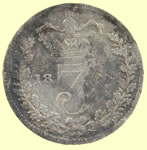 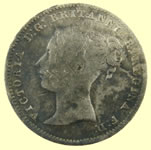 |
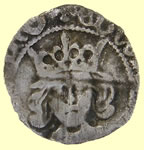  |
||
1864 Victorian milled silver 3 pence |
1327 Edward III hammerd silver florin penny Obv EDWARDVS REX ANG Obv VIL/LAR/ADI/NGY - Reading mint |
||
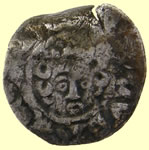 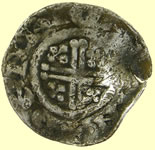 |
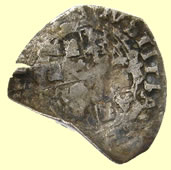 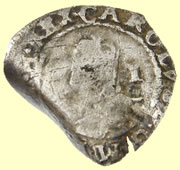 |
||
1199 King John hammered silver short cross penny Rev HEN/RIO/NLV/NDE - Moneyer Henri of London |
1625-6 Charles 1st hammered silver penny - Cross Calvary mint mark |
||
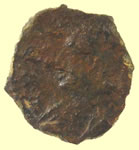 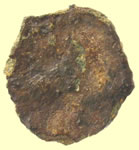 |
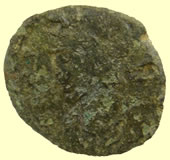 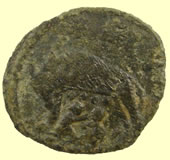 |
||
4thC Roman coin sent for ID |
4thC Roman coin sent for ID 16.67mm, 1.41g You're correct that this coin has a Shewolf & Twins reverse which is typically found on the VRBS ROMA, City of Rome commemorative, reduced-module folles introduced around 330 AD., at the time Constantinople became the official seat of Constantine's government. These have a helmeted and mantled bust of the allegorical personification of the City of Rome facing left on their obverses. At approximately 17mm (although at 1.41gm, it's on the light side) it's most likely from the emissions of c 330-333/5, rather than the later ones of 333/5-337 which tended to be even smaller. At some mints, they were even continued as a type past the death of Constantine in 337, although often paired with a "Vota" or a GLORIA EXERCITVS soldiers & standard reverse rather than the wolf & twins. This atypical use of a subject other than an Imperial bust on the obverse was a convenient political "dodge" for cities which hadn't necessarily declared-for or been brought securely into the fold of one or another of Constantine's sons, who had some "disagreement" about who had inherited what territory or was to rule where, etc.
Unfortunately, the exergual area is too far off-flan for me to be able to make an informed guess as to the city of origin - top seriph-tips of a few letters are visible, but not enough to really be able to tell what was intended.
For a somewhat clearer view of the type, see: http://www.stoa.org/gallery/album165/52_VRBS_CYZ or: http://www.stoa.org/gallery/album165/57_VRBS_TES and as you can see from the first example, these were originally silver-washed, although the silvering very seldom survives to the present day.
Mark
|
||
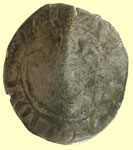 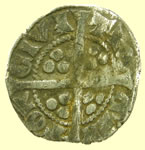 |
 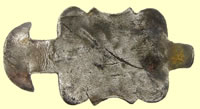 |
||
1279 Edward 1st hammered silver penny - Class 10ab Obv +EDWR R ANGL DNS HYB Rev CIVI/TAS/CAN/TOR - Canterbury mint |
18thC silver decorated clog fastener |
||
  |
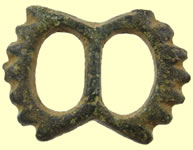 |
||
Medieval buckle with chape - 2 rivet fixing |
1550 -1650 buckle |
||
 |
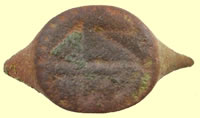 |
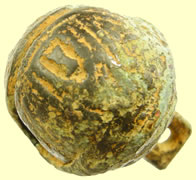 |
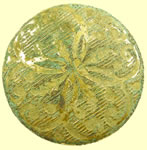 |
Medieval decorated buckle fragment |
17thC seal ring |
17thC crotal bell with I foundry mark |
Georgian button |
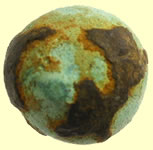 |
 |
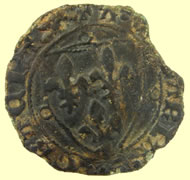 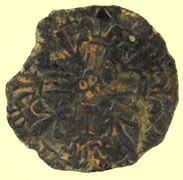 |
|
| Roman bronze pin head |
Kent regiment cap badge |
1340 Shield of France Jetton |
|
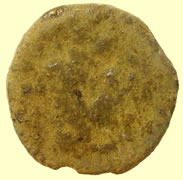  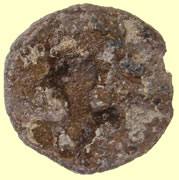 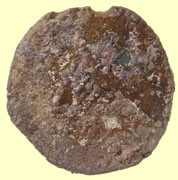 |
|||
Republican Roman silver coin - 'cooking' it to remove horn crust |
|||
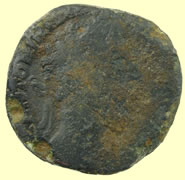 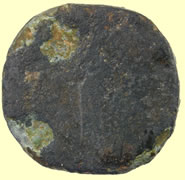 |
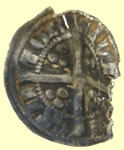 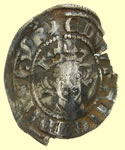 |
||
|
Huge 2ndC Roman sent off for ID 28.21mm dia x 4.58 mm thick 19.14g This is a sestertius of Marcus Aurelius - 161-180 AD. I don't think I can tell you a lot more on the basis of what I can see here. The reverse shows one of literally dozens of standing female allegorical personifications or minor deities Aurelius used on his coins over the course of 2 decades as Augustus (of course, he had already had 2 decades of extensive coinage before this as Caesar under Antoninus Pius). There aren't any obvious clues as to which it might be. That, and the 2nd half of the obverse legend being missing or illegible means I can't date it more closely than to say this dates to his time as emperor, 1st part of the 2nd half of the 2nd century AD..
Mark
| 1341 Edward III hammered silver florin penny Obv +EDWR ANGL DNS HYB Obv EDW Rev CIVI/TAS/CAN/TOR - Canterbury mint |
||
 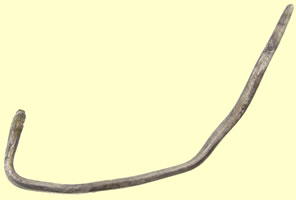 |
|||
Medieval silver bodkin needle - reported to museum as treasure |
|||
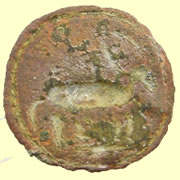 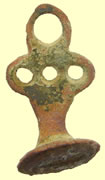 |
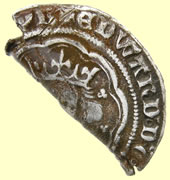 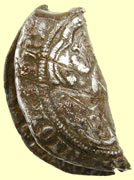 |
||
17thC seal matrix |
Taco'd 1351-2 Edward III hammered silver groat - Cross 1 |
||
As dug and 'partial cooking'
Roman silver coin still 'cooking' it to remove horn crust
Huge 4th to 6thC bronze brooch 47.63mm W, 30.66g Either Longbow or Cruciform type |
|||
 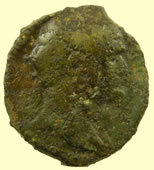 |
|||
3rd C Roman bronze coin sent off for ID 23.40mm, 4.57g As of Hadrian, 117-138 AD
|
|||
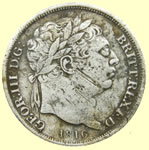 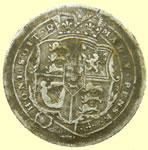 |
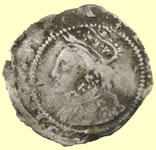 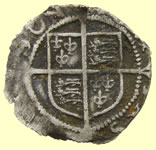 |
||
1816 George III milled silver sixpence |
16thC Elizabeth 1st hammered silver penny |
||
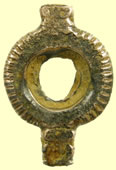 |
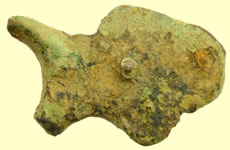 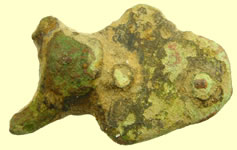 |
||
Georgian gold plated watch winder |
C10thC Saxon harness fitting - 2 rivet fixing |
||
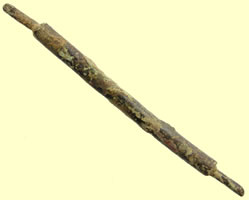 |
  |
||
Roman writing stylus |
17thC mount with 2 integral lugs |
||
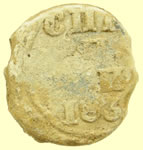 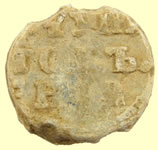 |
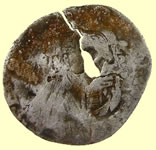 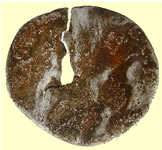 |
||
1830 Russian lead bale seal |
1625 Charles 1st hammered silver half groat |
||
 |
|||

